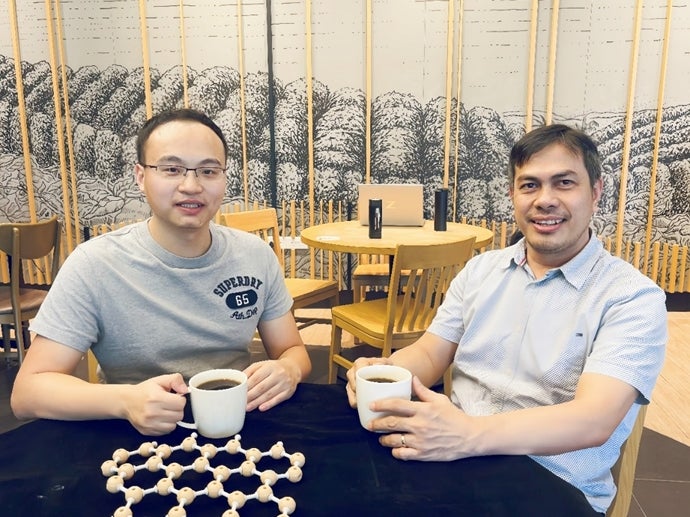Empowering emerging researchers: The Young Investigator Research Grant (YIRG)
April 09, 2024
Dr HU Junxiong (left) and Professor Ariando (right) enjoying a cup of coffee at a NUS University Town café to celebrate Dr Hu being awarded the Manufacturing, Trade and Connectivity (MTC) Young Individual Research Grant (YIRG). This grant aims to nurture young researchers in conducting independent research.
Dr HU Junxiong, a Senior Research Fellow and his academic mentor Professor Ariando, both from the Department of Physics, NUS frequently meet up to exchange insights on research pointers and develop plans for their research directions. During their latest meeting, amid their usual scholarly exchanges, they also celebrated Dr Hu’s achievement in receiving the Manufacturing, Trade and Connectivity (MTC) Individual Research Grant (IRG).
Highly competitive, the MTC YIRG award aims to support novel and fresh investigator-led R&D ideas. Proposals for this initiative are sought through a ground-up mechanism across the local research ecosystem.
Reflecting on his achievement, Dr Hu said, “I am deeply honoured to receive the MTC YIRG award. I believe it serves as a beacon of inspiration for aspiring young scholars from the Faculty of Science. With this grant, I have the opportunity to enhance my leadership abilities in research planning, execution and dissemination.”
The awarded three-year project “Towards robust, stable and high-sensitivity magnetic field sensor based on the quantum critical regime of graphene” involves developing hybrid Dirac two-dimensional (2D) materials and functional oxide heterostructures and interfaces. The objective is to harness the full potential of oxide functionalities, including metallicity, ferroelectricity, ferromagnetism and superconductivity, to study their influence on the interface properties of 2D materials. Employing the “materials-by-design” approach, Dr Hu previously made significant breakthroughs in the study of emergent properties in quantum materials, inducing the giant magnetoresistance effect [1], large and tunable spin splitting effect [2], and the controlled alignment of supermoiré lattice structures [3].
References
[1] Hu JX; Gou J; Yang M; Omar GJ; Tan JY; Zeng SW; Liu YP; Han K; Lim Z; Huang Z; Wee ATS; Ariando A*, “Room-Temperature Colossal Magnetoresistance in Terraced Single-Layer Graphene” Advanced Materials Volume: 32 Issue: 37 DOI: 10.1002/adma.202002201 Published: 2020.
[2] Hu JX; Han YL; Chi X; Omar GJ*; Al Ezzi MME; Gou J; Yu XJ; Andrivo R; Watanabe K; Taniguchi T; Wee ATS; Qiao ZH*; Ariando A*, “Tunable Spin-Polarized States in Graphene on a Ferrimagnetic Oxide Insulator” Advanced Materials DOI: 10.1002/adma.202305763 Published: 2023.
[3] Hu JX; Tan JY; Al Ezzi MM; Chattopadhyay U; Gou J; Zheng YT; Wang ZH; Chen JY; Thottathil R; Luo JB; Watanabe K; Taniguchi T; Wee ATS; Adam S; Ariando A*, “Controlled alignment of supermoire lattice in double-aligned graphene heterostructures” Nature Communications Volume: 14 Issue: 1 DOI: 10.1038/s41467-023-39893-5 Published: 2023.


